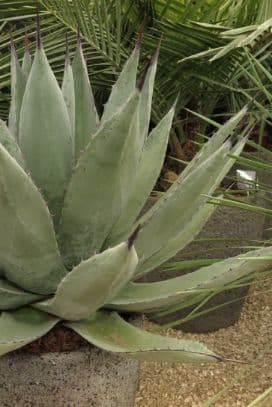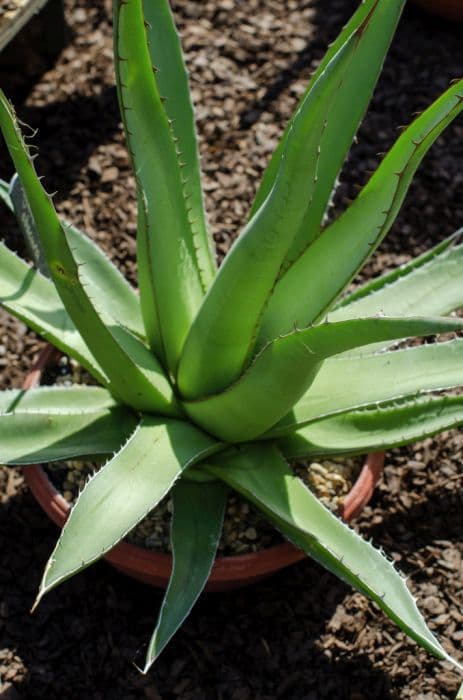Variegated Century Plant Agave americana 'Mediopicta Alba' (v)

ABOUT
Agave americana 'Mediopicta Alba', commonly known as 'Century Plant', is a striking succulent with a bold and unique appearance. The plant showcases stiff, upright leaves that radiate from the base in a rosette-like formation. These leaves are thick and fleshy, designed to store water, which is typical for plants that thrive in arid environments. The leaf color is a dramatic variegation — the central part of each leaf is a creamy white or soft alabaster, which then blends seamlessly into a blue-green or gray-green color that dominates the edges. This variegation pattern creates a sharp contrast which is visually appealing and makes the plant stand out. The edges of the leaves are lined with marginal spines that are sharp to the touch. This feature adds a sense of rugged beauty but serves as a warning for those who might handle the plant. In addition to the marginal spines, the leaves typically culminate in a sharp, pointed end, adding to its striking visual profile. The overall form of the Century Plant is architectural, with its rigid leaves forming a symmetrical pattern that is both elegant and formidable. Its impressive, sculptural quality makes it a popular choice for gardeners who want to add a touch of drama and exotic flair to their landscapes or container gardens.
About this plant
 Names
NamesFamily
Asparagaceae.
Synonyms
Americana Alba, White-Striped Century Plant, Variegated Century Plant, Alba Mediopicta Agave.
Common names
Agave americana var. medio-picta f. alba, Agave americana 'Marginata', Agave americana 'Variegata', Agave americana var. medio-picta 'Alba', Agave americana f. medio-picta alba, Agave americana 'Mediopicta Alba'.
 Toxicity
ToxicityTo humans
The Century Plant or Agave americana 'Mediopicta Alba' contains toxic sap that can cause skin irritation and allergic reactions upon contact. Ingesting parts of the plant can lead to severe irritation of the mouth and throat, swelling, and potentially could cause difficulty in breathing due to the throat swelling. Symptoms may include a burning sensation, pain, nausea, vomiting, and diarrhea. Handling the plant, including its leaves and sap, should be done with care and proper protective equipment.
To pets
The Century Plant is toxic to pets, such as dogs and cats, if ingested. The plant contains saponins and oxalates, which can cause symptoms like vomiting, diarrhea, drooling, loss of appetite, depression of the central nervous system, and rarely, tremors. Pets may also experience irritation and swelling around the contact area if they come into contact with the sap or puncture their skin with the plant's sharp leaves. It is essential to prevent pets from chewing or ingesting parts of this plant to avoid poisoning.
 Characteristics
CharacteristicsLife cycle
Perennials
Foliage type
Evergreen
Color of leaves
Variegated
Flower color
Yellow
Height
2-3 feet (0.6-0.9 meters)
Spread
2-4 feet (0.6-1.2 meters)
Plant type
Succulent
Hardiness zones
8
Native area
Mexico
Benefits
 General Benefits
General Benefits- Ornamental Value - Agave americana 'Mediopicta Alba' offers striking variegated foliage that adds aesthetic appeal to gardens and landscapes.
- Drought Tolerance - This succulent is highly drought-resistant, making it ideal for xeriscaping and water-wise gardening.
- Low Maintenance - The plant requires minimal care, making it suitable for gardeners seeking low-maintenance options.
- Longevity - It is a long-lived plant that can provide structural interest in the garden for many years.
- Resilience to Pests - Resistant to most pests and diseases, reducing the need for chemical interventions.
- Adaptability - Can thrive in a variety of soil types, as long as they provide good drainage.
- Architectural Structure - Provides strong architectural form that can serve as a focal point in landscape design.
- Suitable for Containers - Can be grown in pots, which makes it versatile for patios, balconies, and indoor settings (with adequate light).
- Attracts Wildlife - Flowers attract pollinators such as bees, hummingbirds, and butterflies.
- Sustainability - Being perennial and requiring few resources, it contributes to sustainable garden practices.
 Medical Properties
Medical PropertiesThis plant is not used for medical purposes.
 Air-purifying Qualities
Air-purifying QualitiesThis plant is not specifically known for air purifying qualities.
 Other Uses
Other Uses- Agave Americana fibers can be used in the production of durable textiles and ropes due to their strong and resilient nature.
- The leaves of the Century Plant can be processed to extract waxes and oils that are useful in the cosmetic industry.
- Century Plant sap can serve as a natural adhesive or binding agent in various indigenous craft practices.
- The spines at the tips of the plant's leaves can be utilized as natural needles or small carving tools.
- Dried sections of the plant have been used as natural acoustic materials in traditional musical instruments.
- The strong frame of the mature plant's dried flower stalks can be repurposed as lightweight building materials or for making furniture.
- Leaf imprints of the Century Plant can be used in art to create unique botanical prints and patterns.
- Dried leaves from the plant may be used as fuel in traditional earth ovens in regional cuisines.
- The plant's large leaves and rosettes can serve as natural barriers or living fences in dry, arid environments.
- Parts of the plant, excluding the sap, can be incorporated into compost to enrich the soil as they break down.
Interesting Facts
 Feng Shui
Feng ShuiThe Century Plant is not used in Feng Shui practice.
 Zodiac Sign Compitability
Zodiac Sign CompitabilityThe Century Plant is not used in astrology practice.
 Plant Symbolism
Plant Symbolism- Resilience: Known for its ability to survive in arid, inhospitable environments, Agave represents toughness and the capacity to endure tough conditions.
- Adaptability: This plant can adapt to many different soil types and weather conditions, symbolizing the ability to thrive in various situations.
- Purity: The 'Mediopicta Alba' variety has white stripes in its foliage, often associated with purity and cleanliness in various cultures.
- Protection: With its sharp points and robust structure, Agave can symbolize protection and defense against harm.
- Longevity: Agave plants can live many years and take a long time to flower, representing longevity and the idea of long-term growth or investment.
 Water
WaterThe Century Plant should be watered sparingly as it is drought-tolerant. During the growth season, water it once every two weeks using approximately 0.25 gallons each time, depending on the size of the plant and pot. Ensure that the soil is completely dry before watering again. In the winter, reduce watering to once a month, or even less, as overwatering can lead to root rot. Tailor your watering schedule to your environment, as indoor plants may require less frequent watering than those in hotter, sunnier climates.
 Light
LightThe Century Plant thrives in full sun to partial shade conditions. It's best positioned in a spot where it receives plenty of direct sunlight for most of the day. An outdoor location with direct exposure to the sun's rays is ideal, ensuring that the plant gets at least six hours of sunlight daily.
 Temperature
TemperatureCentury Plants prefer temperate conditions and can survive a range of temperatures, generally from 30°F to 80°F. They can withstand short periods of colder temperatures down to about 25°F but should be protected from frost. The ideal temperature range for optimal growth is between 50°F and 70°F.
 Pruning
PruningPruning the Century Plant is primarily about removing dead or damaged leaves and spent flower stalks for the plant's health and appearance. Pruning should be done with care, using gloves and protective clothing, as the plant's sap can be irritating to the skin, and leaves can be sharp. The best time to prune is in the spring or early summer.
 Cleaning
CleaningAs needed
 Soil
SoilThe ideal soil mix for Century Plant (Agave americana 'Mediopicta Alba') is a well-draining cactus or succulent mix, with added perlite or coarse sand for increased drainage. The soil pH should be slightly acidic to slightly alkaline, ranging from 6.0 to 8.0.
 Repotting
RepottingCentury Plants should be repotted every few years or when outgrowing their container. They are slow-growing and can remain in the same pot for years until they become pot-bound.
 Humidity & Misting
Humidity & MistingCentury Plant thrives in low humidity environments and does not require high humidity levels, making it suitable for dry indoor climates.
 Suitable locations
Suitable locationsIndoor
Place in bright light, avoid overwatering, and ensure good airflow.
Outdoor
Full sun, well-draining soil, protect from extreme cold.
Hardiness zone
8-11 USDA
 Life cycle
Life cycleCentury Plant 'Mediopicta Alba' begins its life as a seed, typically germinating in well-draining soil with low moisture levels. Once the seed germinates, a small rosette of variegated leaves begins to grow; this stage can last for several years as the plant slowly matures. During its growth, the rosette expands, developing long, pointed leaves with white to cream-colored stripes down the center. After a considerable number of years, ranging from 10 to even 60, the plant reaches maturity and sends up a towering flower stalk, which can grow up to 15 feet or more, producing yellow-green flowers that attract pollinators. Following the flowering stage, the Century Plant completes its life cycle by setting seeds and then dying, but not before producing several offsets or "pups" around its base, which can be detached and planted to start new plants. These life stages underscore the long-lived nature of the plant, culminating in a singular dramatic flowering event at the end of its life cycle.
 Propogation
PropogationPropogation time
Spring-Early Summer
The Agave americana 'Mediopicta Alba', commonly known as the Variegated Century Plant, is often propagated by separating the small offsets, also known as "pups," that form around the base of the parent plant. These pups usually appear as the parent plant matures, which can take a few years. The optimal time for propagating by offsets is during the warmer months of spring through summer, when the plant is actively growing. To propagate, a gardener would carefully remove a pup from the mother plant by cutting it with a sharp, clean knife or spade, ensuring that each pup has some roots attached. The cut should be allowed to callous over for a few days to prevent rot, then the pup can be planted in well-draining soil. A mixture of potting soil with sand or perlite is ideal. Water sparingly at first, just enough to moisten the soil, and gradually increase as the plant establishes itself, usually about once a week or according to local humidity and temperature conditions.









